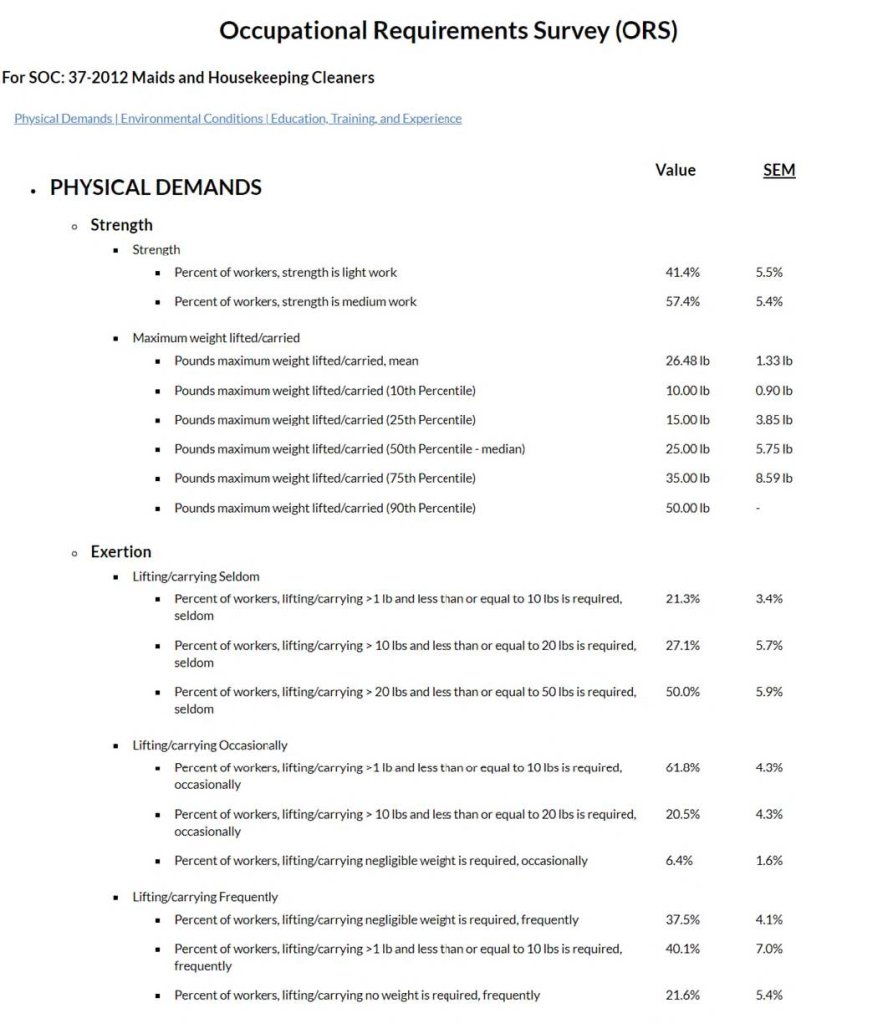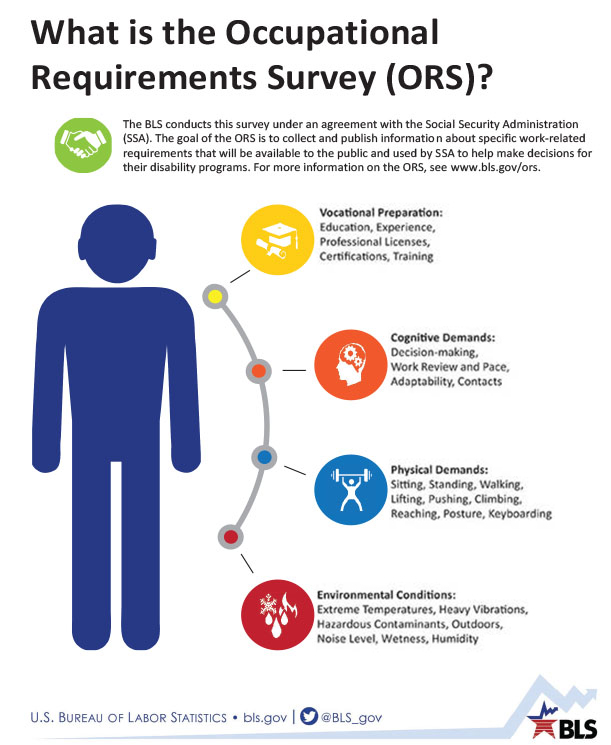by Brenda Martinez Richardson, MS, CRC, PVE, IPEC
What is The Occupational Requirements Survey (ORS)?
The Occupational Requirements Survey (ORS) is a product of the Bureau of Labor Statistics (BLS). The ORS is commissioned by the Social Security Administration (SSA). The results are meant to replace the use of Dictionary of Occupational Titles (DOT) classifications and to update occupational requirements for administering the Social Security Disability Insurance (SSDI) and Supplemental Security Income (SSI) programs.
ORS Provides Job-Related Information
The ORS is an establishment-based survey in the 50 states and the District of Columbia to produce estimates of occupational requirements for Standard Occupational Classification (SOC) occupational groups. Private sector and both state and local government establishments are eligible for selection but workers in federal and quasi-federal agencies, military personnel, agriculture workers, workers in private households, self-employed, volunteers, unpaid workers, individuals receiving long-term disability compensation, and those working overseas are excluded (BLS, 2020). ORS data is collected via survey with selected occupations having annual onsite observations. The ORS collects information on requirements based on how selected jobs are generally performed without accommodations. It collects information regarding what critical job functions are required. The anticipated results of the survey will describe job requirements, not worker characteristics (BLS, 2020). The ORS provides job-related information regarding incidence and duration of physical demands and environmental conditions; cognitive and mental requirements; as well as education, training, and experience needed for jobs in the U.S. economy (BLS, 2020).
4 Main Categories for ORS Groups Data
The ORS groups data into four main categories (BLS, 2020):
- Physical demands – The physical activities required to perform occupational tasks (e.g., Strength, Exertion, Reaching, etc.) Results are reported in a manner to assist SSDI and SSI programs, similar to Appendix C Physical Demands of the Selected Characteristics of Occupations (SCO).
- Environmental conditions – The various tangible or concrete hazards or difficulties that are in the vicinity of which a job is performed (e.g., Environment, Hazards, etc.). Results are reported in a manner to assist SSDI and SSI programs, similar to Appendix C Physical Demands of the SCO.
- Education, training, and experience – Known as specific vocational preparation (SVP) and refer to the amount of preparation time required for a typical worker to learn the techniques, acquire the information, and develop the skill needed for average performance in a specific job. The preparation time includes all time spent acquiring the minimum level of formal education required, pre-employment training including certifications and licenses, on-the-job training, and prior work experience.
- Cognitive and mental requirements – The requirements related to a worker’s need to use judgment, make decisions, and adapt to changes on the job.
Example
Selected Variables for SOC 37-2012 Maids and Housekeeping Cleaners:

Complete ORS data can be accessed at https://www.bls.gov/ors/data.htm
Summary
- Vocational experts can use ORS data to support opinions to common hypotheticals in areas where previous data was limited (e.g., sit/stand, interpersonal contact, reaching overhead, etc.).
- ORS data is collected and reported as a percentage within an SOC occupational group. An occupation is different from a job because it refers to a profession or trade in general. It is not a single job, single DOT, or single establishment.
- Since ORS data is collected and reported as a percentage within the SOC occupational group, only a single limitation within the SOC code can be considered at a time. For example, the percent of housekeepers that perform Light work or the percent of housekeepers that have overhead reaching. In order to consider both limitations, a probability estimate is required.
- Currently, ORS is not a recognized source in SSA. SSA is planning to post it to the federal register, have the required comment period, and then the regulation could be changed to include ORS as part of the recognized sources. It has been delayed due to COVID-19.
- ORS data can be used as a source, but the DOT will be considered the primary source for SSA disability programs.
- The ORS does not survey all characteristics surveyed in the SCO.
- The BLS will not be able to capture the job requirements of all SOC codes.

U.S. Bureau Of Labor Statistics, (2020), Occupational Requirements Survey, retrieved June 30, 2020 from https://www.bls.gov/ors/

